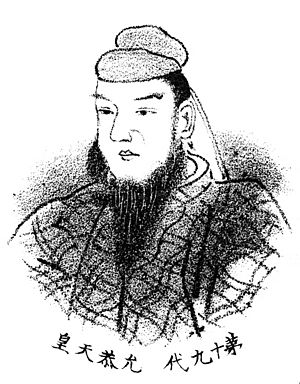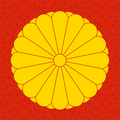Emperor Ingyō facts for kids
Quick facts for kids Ingyō |
|
|---|---|
 |
|
| Emperor of Japan | |
| Reign | 412–453 (traditional) |
| Predecessor | Hanzei |
| Successor | Ankō |
| Born | 376 |
| Died | 453 (aged 76–77) |
| Burial | Ega no Naganu no kita no misasagi (Osaka) |
| Spouse |
|
| Issue | See below |
| House | Yamato |
| Father | Emperor Nintoku |
| Mother | Princess Iwanohime |
Emperor Ingyō (允恭天皇, Ingyō-tennō) was the 19th emperor of Japan. He is part of the traditional order of rulers. Historians believe some details about Emperor Ingyō's life might be like a legend, but they are probably true. His name, Ingyō-tennō, was given to him after he died by people who lived much later.
We don't have exact dates for this emperor's life or when he ruled. The names and order of the early emperors were officially confirmed much later. This happened during the time of Emperor Kammu, who was the 50th ruler of the Yamato dynasty.
Contents
Traditional History of Emperor Ingyō
The ancient Japanese books, the Kojiki and Nihon Shoki, tell us about Emperor Ingyō. They say he was the fourth son of Emperor Nintoku. He was also the younger brother of Emperor Hanzei.
Ingyō had planned for one of his brothers to become the next emperor. However, this plan did not happen as he expected. Instead, his brother's sons would later become emperors. After Ingyō, his nephews, Emperor Ankō and Emperor Yūryaku, took the throne.
Important Events During Ingyō's Time
We know very little about what happened during Emperor Ingyō's life and reign. There is only limited information available for study about rulers before the 29th emperor, Emperor Kimmei.
One of the earliest recorded earthquakes in Japan happened in the year 416. The Imperial Palace in Kyoto was destroyed during this earthquake.
What Happened After His Death
The official name given to this emperor after he died is called his posthumous name. This name was made official many centuries after the time Ingyō was said to have lived.
The Imperial Household Agency says that the emperor's final resting place is in an earthen tumulus. This is a type of ancient burial mound known as a kofun. Emperor Ingyō is honored at a special Shinto shrine called a misasagi. This shrine is located in Fujiidera, a city near Osaka.
Related Pages
Images for kids
-
The chrysanthemum symbol of the Japanese emperor and his family.
| Preceded by Emperor Hanzei |
Legendary Emperor of Japan Ingyō 411-453 (traditional dates) |
Succeeded by Emperor Ankō |
See also
 In Spanish: Ingyō Tennō para niños
In Spanish: Ingyō Tennō para niños


